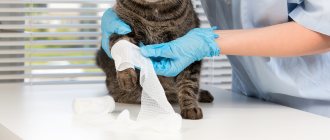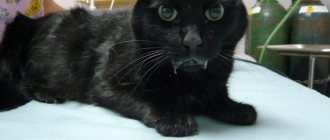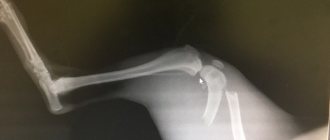Among other reasons for visiting a veterinary clinic, injuries in cats are quite common. And this is not surprising, because by its nature a cat is a very curious and active animal. Among the most common causes of injury are injuries to soft tissues and internal organs as a result of falls from a height, falling under the wheels of a car, crush injuries as a result of getting stuck in windows, fights with other animals, and so on. Naturally, no one, even the most caring and vigilant owner, is able to protect his pet from all potentially dangerous situations, especially since in Moscow they can actually lie in wait for the animal at every turn. That is why it is important to know how to react correctly to the current situation so as not to harm the animal and provide it with the fastest and most effective help.
SOS signal from your pet
So, how will a cat behave after an injury and what should the owner do first? Naturally, if an animal comes back from a walk and has wounds on its body or is bleeding, then the first and most correct action would be to go to the veterinary clinic. Many owners make the mistake of leaving a visit to the doctor for later, because as a result, very often the animal’s condition worsens and in the future it will take much more time and effort to stabilize and restore it. Any external damage, even if it seems minor, can hide much more serious injuries. In addition to lacerations of the abdomen and chest, one can often find damage to internal organs, which pose a great danger not only to the health, but also to the life of the animal. To determine that something is wrong with an animal, it is necessary to have a clear understanding of the symptoms of injury in cats. At first after the injury, the animal may be in shock - then it is overly excited, the pupils are dilated, which also indicates the presence of pain, the cat meows, growls or hisses more than usual, cannot find a place for itself, refuses to be handled, eat or drink . In addition to the excited state, an increase in local or general temperature and tremor can also be observed. After some time, the animal’s condition changes, it becomes lethargic, does not want to get up or move. Some cats continue to scream, and for many, incessant loud purring becomes a kind of defensive reaction. Appetite is most often absent or may be significantly reduced. These are general signs of injury in a cat, but there are also specific ones that directly depend on which organ is damaged and how severe the damage is.
Cat wounds
Most often, cats have bitten, lacerated “battle wounds” received in fights with other cats or dogs. The most obvious sign of such wounds is damage to the skin, which requires appropriate treatment. First of all, the wound must be washed with a disinfectant. A regular solution of furatsilin is suitable for this. If you don’t have a ready-made solution, you can prepare it yourself by dissolving two tablets in a glass of warm boiled water. The surface of the wound is treated with this solution. If possible, remove fur from the area around the injury to prevent hair from sticking to the wound.
When the owner is unable to immediately deliver the injured cat to a veterinarian, she should be given an antibiotic. If the owner does not have a special veterinary antibiotic at hand, it can be replaced with a human drug, for example, Augmentin (amoxiclav). The antibiotic is given in a dosage per 1 kg of animal body weight twice a day. That is, an “average” cat that weighs 3 kg should receive about 50 mg of antibiotic at one time. And, of course, the animal needs to be shown to a veterinarian as soon as possible.
If the cat received a cut wound and started bleeding, then you need to do the following: take a clean, or better yet, sterile napkin, apply it to the surface of the wound and bandage it with moderate force. The pressing effect will reduce bleeding. If a large artery is damaged, it will most likely have to be sutured. Bleeding from small vessels can stop on its own, but treatment of such a wound still requires the supervision of a specialist.
Eye injuries are also common in cats and, unfortunately, in this case, the owner can do practically nothing himself. The damaged eye should be carefully washed with furatsilin solution and immediately consult a doctor.
Mechanical injuries in cats
Open injuries to skin and soft tissues
The most common mechanical injuries in cats are wounds, abrasions and cuts. They can occur as a result of fights with other animals or from contact with cutting or piercing objects. It is quite easy to understand that the cat was injured in this case, because such injuries are characterized by varying degrees of bleeding, hyperemia of the surrounding tissues and painful sensations. Quite often, traumatic swelling occurs, which over time can turn into purulent inflammation, which poses the greatest danger. If the wound is deep enough or covers a large surface area of the animal's body, then surgical treatment is necessary. Large defects that occurred within 1-2 hours before seeking veterinary help can be thoroughly treated with antiseptic agents and closed with a blind suture. If the damage was received earlier or the condition of the wound suggests that it is infected, then there is a need for partial closure of the defect. In both cases, after the initial treatment of the cat’s injury, subsequent treatment is prescribed, including the use of antibiotics, anti-inflammatory and painkillers. Often open wounds heal fairly quickly and the animal recovers easily. The first aid that the owner can provide at home is treating the wound with an available antiseptic, for example, chlorhexidine solution, completely or partially stopping the bleeding and promptly visiting a veterinary clinic. In a hospital setting, the doctor carefully examines the patient to exclude concomitant internal injuries, conducts the necessary studies, and only then prescribes appropriate treatment.
Abscesses
In those animals that are free-range and in contact with their own kind, abscesses are very common - limited inflammatory foci in an organ or tissue, characterized by the formation of a cavity filled with purulent contents. By its nature, this injury occurs when deep microtraumas occur with the introduction of pyogenic microflora into the animal’s body. Outwardly, it is quite difficult for the owner to immediately determine the cause of the animal’s illness. Moreover, it takes some time for visual signs to appear. When contacting the clinic, owners pay attention to the fact that a swelling forms in the area of injury, which causes anxiety to the animal. As pus accumulates in the cavity that has formed, the animal experiences pain, an increase in local and sometimes general temperature, and quite often lethargy and refusal to eat are recorded. With this type of injury in a cat, help consists of surgically opening the abscess, thoroughly treating the resulting cavity, and then draining it. In certain cases, a course of antibiotics is necessary. The danger of this type of injury lies in the fact that microorganisms that have entered the body multiply quickly, and the resulting purulent contents increase and can spread into the surrounding tissues, which makes the process more complex and dangerous.
Bruises and hematomas
This is a type of mechanical injury that is accompanied by pain, swelling, increased local temperature and, in the case of hematomas, the formation of a cavity filled with blood. Separately, we should highlight otohematomas or hematomas of the auricle, which arise as single injuries or complicate the course of other diseases, for example, otitis media or otodectosis. The mechanism for the development of such damage is due to the fact that when there is itching in the area of the auricle, the animal scratches or breaks the vessels located inside, which, in turn, begin to bleed, forming a cavity. Treatment of this type of injury consists of eliminating the underlying disease, as well as opening or aspiration of the contents of the formed cavity. At the next stage, drug treatment is used, as well as surgical elimination of the defect (suturing the hematoma).
Transportation to the clinic
Fracture of two paws at once
At this stage, all possible assistance from the owner has been provided. All that remains is to call a veterinarian or take the victim to the clinic. When transporting, the animal must be kept in a lying position on a hard surface.
Only a doctor can determine the degree of complexity of a fracture or bruise, its type and treatment methods by palpation or, if necessary, using an x-ray.
For minor fractures, conservative treatment is used, i.e. splints, splints and bandaging . In more complex cases and always with hip fractures, surgical intervention and the use of metal structures such as pins, plates, cerclage .
After visiting the doctor, the owner must strictly follow the recommendations given by the doctor. After surgery, you will need to inject antibiotics to avoid infection or rejection of the foreign body. After a certain time, you need to show up on time to remove the bandage or pin.
Car injuries in cats
The most dangerous type of injury, since when a cat gets under the wheels of a car, it suffers multiple injuries, both external and internal. It is very rare that such situations do not have serious consequences. If an accident occurs with an animal, it must be immediately taken to the nearest veterinary clinic. The first aid that the owner can provide in such a situation is limited to applying a tourniquet or tight bandage in the presence of bleeding, as well as fixing the pet in one position as much as possible. Already in the hospital, the doctor will be able to determine the presence of internal injuries that may require emergency surgical treatment, fractures of the bones of the limbs, and the spine. Injuries sustained in a car collision require long-term stabilization of the patient’s condition, compensation for blood loss, which most often accompanies them, and other special treatment measures.
Fractures in cats
Among the most common car injuries in cats are fractures. These may be multiple fractures of the limbs or spine, combined injuries of bones and soft tissues. Regardless of what damage the animal received, the first and most important task of the doctor in this situation is to stabilize the general condition of the patient. First of all, it is necessary to use pain medication for a cat in case of injury, since severe pain in combination with general stress and the resulting injuries can lead to irreversible consequences. Owners should remember that not all traditional humane pain relief remedies are suitable for a pet. There are a number of drugs, the use of which is strictly prohibited in cats, as they can lead to poisoning.
After providing first aid and a complete thorough examination of the animal, a decision is made on subsequent treatment. Often you may encounter a situation where treatment will take place in several stages, since the animal’s body is not able to withstand the stress associated with anesthesia and surgical manipulations. For single fractures of the limb bones, osteosynthesis is recommended. The course of the operation and its urgency are determined by the doctor based on data on the general condition of the animal and the type of fracture.
How to identify a bruise
When a cat has a paw injury, it becomes immediately noticeable. The first sign of injury: the injured animal holds the injured limb suspended and tries not to step on it. If a cat stands on a bruised paw, it limps heavily, trying to immediately transfer its weight to other limbs. Damage to a cat's limb, if it is a bruise, has the following main manifestations:
- swelling of the paw - a limb, like any organ, swells due to the fact that blood and lymph from damaged vessels accumulate in the subcutaneous tissue;
- hematoma at the site of injury;
- there is no wound on the skin;
- there are no abnormalities in the structure of the paw and its joint;
- gait disturbance due to severe lameness;
- the cat constantly licks the sore paw in order to massage the tissues with the tongue and accelerate the resorption of the hematoma;
- the aggressiveness that the cat displays when the owner tries to touch the sore paw;
- local temperature increase.
It doesn’t matter whether a severe bruise of the hind paw or the front paw occurs; normally it goes away within 5-7 days. Gait disturbances and swelling completely disappear, and the pet returns to its normal rhythm of life. Treatment for a bruise is generally not required, but to quickly eliminate symptoms, you can use drugs that will speed up the resorption of swelling. If the recovery is delayed, it means that, in addition to the bruise, there is a sprain, and the help of a doctor is needed.
Traumatic hernias
Quite often, as a result of impacts in the abdominal wall, hernias are formed - the prolapse of internal organs (intestines, bladder) beyond the abdominal wall as a result of rupture of its muscles and tendons. At the same time, the integrity of the skin is preserved. Externally, this type of injury looks like a swelling, sometimes accompanied by a hematoma, in the area of the central abdominal wall and groin. Depending on the type of hernia, and it can be strangulated or not strangulated, reducible or irreducible, the general condition of the animal also changes. With a non-strangulated hernia, most often the animal does not experience severe pain or discomfort, and the area of prolapse does not show signs of inflammation. Urination and defecation also do not always undergo any changes. The danger of a non-strangulated hernia is that strangulation can occur at any moment, which is accompanied by severe pain, hyperemia, and dysfunction of the prolapsed organ. This type of injury requires immediate surgical intervention. In the presence of a non-strangulated hernia resulting from an injury to the abdominal wall, surgery is also indicated, but in this case we are talking about a planned intervention. During the operation, the doctor determines the presence or absence of damage to the prolapsed organ; if everything is in order with the organ, then it is returned to the abdominal cavity, and the defect is restored.
Abdominal injuries
Bladder rupture
This type of injury occurs in animals as a result of a strong blow. Kittens have a very thin, imperfect abdominal wall and a fairly small layer of subcutaneous fat that could prevent injury to the abdominal organs, which is why even a relatively weak blow can lead to a rupture of the bladder. Symptoms of such damage are the depressed state of the animal, decreased or complete absence of appetite, increased general body temperature, pain in the abdominal cavity, complete or partial absence of urination, or hematuria. To make a diagnosis, it is necessary to conduct special studies - ultrasound of the abdominal organs, x-ray examination, retrograde urethrocystography and excretory urography. If a bladder rupture is confirmed, the cat is scheduled for surgery to repair the rupture. During the operation, the surgeon inspects the internal organs to determine associated damage and, if any, eliminates them. After surgery, the animal needs subsequent rehabilitation therapy and requires special postoperative care.
Spleen, liver and kidneys
Falls from a height or strong impacts in cats can lead to damage to one or more abdominal organs, among which one of the most dangerous is a ruptured spleen. Its danger lies in the fact that the organ is highly vascularized, which means that if damaged, there is a high risk of severe bleeding. The main signs of this type of injury are general weakness of the animal, a spongy state, pain in the abdomen, sometimes an increase in its volume (this occurs due to massive bleeding and accumulation of blood in the abdominal cavity), the abdomen is tense, the mucous membranes of the animal (conjunctiva, oral mucosa) ) pale, even marble-colored. This condition can occur quite quickly, within 2-4 hours after the injury, and the longer the animal is left without veterinary care, the less chance of its salvation. If a rupture of the spleen is suspected, a number of studies are carried out: a general blood test, ultrasound, x-ray of the abdominal cavity; often a diagnostic laparotomy may be necessary, during which the surgeon will inspect all organs of the abdominal cavity and eliminate the detected lesions. In the case of the spleen, quite often when it ruptures, a splenectomy is required, that is, removal of the damaged organ. In the future, its absence will not greatly affect the animal’s quality of life.
Unlike the spleen, the liver and kidneys rarely cause severe bleeding when damaged, but control over the animal’s condition is necessary. For liver injuries, surgery is often used as a treatment, as a result of which only the damaged vessels are ligated, and the organ itself is not touched; in especially severe cases, it becomes necessary to remove a certain lobe or lobes of the liver, which also does not affect the cat’s life expectancy in the future.
As first aid, which can be provided to a pet immediately after an injury and before visiting a veterinary clinic, it is possible to apply a tight bandage to the abdomen. This will prevent severe blood loss and will temporarily stabilize the animal’s condition. However, such a bandage must be applied for a minimum period of time, otherwise the blood supply to all abdominal organs will be disrupted due to pressure, which will negatively affect the pet’s condition.
Operation for advanced cases
Surgery is necessary for advanced or complex dislocations.
After receiving an injury, the dislocation must be corrected as soon as possible. Delay in receiving medical help leads to muscle contraction, the formation of a dense blood clot and scar tissue. These changes make it difficult to reduce the dislocation using a closed method. In such cases, the question arises about surgical treatment of advanced dislocations.
During the operation, during which the animal is asleep, an incision is made in the joint area, through which fibrin clots and destroyed parts of the joint are removed. The joint returns to its original position; this will require force or special levers. A joint reduced openly also requires fixation and temporary immobilization.
Sometimes a cat requires surgical fixation of a joint:
- for dislocations of the hip or wrist joints, it is carried out using special pins;
- for elbow and ankle - screws and wires.
Congenital dislocations in furry pets are usually eliminated using the open method. After a minor dislocation, the animal recovers within 3-4 days. The cat can use its paw, but has a slight limp. Full recovery from severe dislocations takes about 3-4 weeks.
Spinal injuries and their consequences
The spine in cats is injured quite often, but the consequences can be completely different. If we are talking about bruises, then over time the functions are restored and the animal continues to live a full life. It is much worse when a fracture of the spine occurs with rupture and damage to the nerve endings and spinal substance. In this case, the cat may remain spinal for the rest of its life, which means that the back of its body will be paralyzed. After such an injury, the cat experiences fecal and urinary incontinence, paralysis of the hind limbs and tail, while the animal is able to move on its front legs, eat and can live quite a long time. Sometimes complex spinal surgery helps solve the problem, but in most cases, it is not possible to restore all functions. As a warning to owners, it is worth saying that such conditions arise not only as a result of falls or car injuries; the cause can be a simple animal getting stuck in a plastic window. In the summer, many people leave windows in vertical ventilation mode, when the upper part of the window is open but the lower part is not. Since apartment cats often like to hunt birds and insects flying by, as well as for the sake of curiosity, they jump into the resulting gap and get stuck in it. Attempts to get out end with the animal getting stuck even more, and compression occurs, disrupting hemodynamics in the body. As a result, tissues and organs do not receive sufficient blood supply and lose their function. The longer the cat spends in this position, the worse the prognosis for recovery.
Life After Trauma: Recovery
The recovery of a cat after an injury depends on how severe the damage was, how many and which organs were damaged, whether first and subsequent veterinary care was provided and how quickly this was done. That is, the recovery period depends on many factors and in each specific case may take different times and require different treatment. The only thing that remains unchanged is that any incident, even a seemingly insignificant one, must be monitored by a specialist. If your pet falls, gets hit by a car, gets stuck in a window, or gets into a fight, take it to the doctor. The clinic will always treat such a visit with understanding and will do everything possible to keep your cat healthy and active.
A kitten has a bruised paw: why is contacting our veterinarian the right decision?
Any mechanical damage, regardless of the cause, and a bruised paw in a kitten, is stressful for the animal and often causes serious problems later. In some cases, even a slight bruise of the first and second degrees does not go away without a trace for the cat.
If a kitten or adult cat has injured its paw and is limping, then a timely visit to the YA-VET veterinary emergency center will help deal with the injury as quickly as possible without consequences and expensive treatment.
. Correct diagnosis and qualified assistance from veterinarians who have extensive experience working with cats of any age guarantee that the injury will go away as soon as possible, and the pet will enjoy excellent health and the same activity!
We have everything necessary to ensure that mechanical damage to the limbs occurs with the least risk. Veterinary center specialists will find out why the animal is limping and prescribe effective treatment for a specific case. Veterinarians have modern diagnostic equipment, a full-fledged hospital, and their own laboratory at their disposal.
Call us and find out how much emergency veterinary care costs in order to order a visit from specialists without overpayments!










